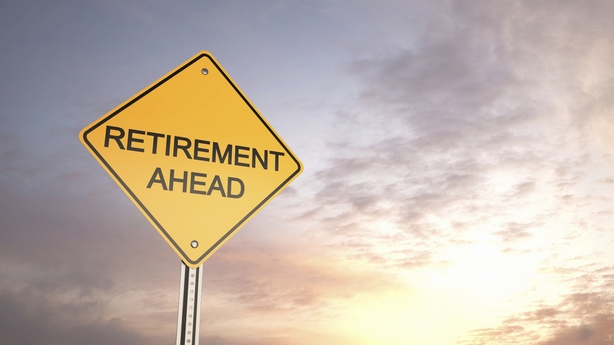Pensions gap widens as pandemic deepens the divide
Psychologists say we have very little appreciation or concept of ourselves in the future.
In other words, our future selves are strangers to each of us.
This lack of relationship with our older selves partly explains why we are so bad at planning for the longer term, such as saving towards retirement.
According to research published in recent weeks by Standard Life, just under half of people of working age here have an occupational pension here.
That’s down from just over half at the end of last year.
It suggests that as more workers move into retirement, fewer younger people of working age are entering into pension schemes.
And indeed, that is borne out by findings from the CSO last year that as few as one in four 20 to 24 years olds were contributing to a pension scheme.
That’s a problem for society and suggests that increasing numbers of us will be reliant on the state pension in retirement and will simply be unable to maintain lifestyles that we’ve become accustomed to during our working lives.
Growing divide
For many, contributing to a pension is a deferred priority to be dealt with by our unfamiliar selves sometime in the future.
Many believe they have enough difficulty making ends meet in the current environment.
And the pandemic has served to exacerbate that feeling with many younger workers in particular moving onto wage supports for a period which made contributing to a pension a luxury they couldn’t afford.
However, for those workers who held onto their jobs and earnings, were mostly working from home, and had fewer opportunities to spend during lockdown, they were putting record amounts of cash aside every month, and some of it was going into pensions.
According to a survey of pension advisors by the Independent Trustee Company, around half said they had seen an increase in demand for retirement planning services since the pandemic began.
And around two in five pension savers increased their monthly contributions.
While it is good news in the round that people are putting more money into pensions, it appears to be confined to a certain cohort.
And that’s contributing to a growing divide between those who are paying into pensions and those who are not in a position to save for retirement.
Auto-enrolment
An attempt to address the divide is coming in the form of a plan to compel workers to start saving towards retirement.
The scheme of ‘auto-enrolment’ – where employees are automatically enrolled into a pension scheme and receive contributions from both the State and their employer – was to have been in place by now, but the date has been pushed back to next year or the year after.
“They haven’t been very specific about when it will be introduced,” Jerry Moriarty, CEO of the Irish Association of Pension Funds explained.
“There are still some major decisions to be made around design and structure. They’re due to be made this year and then there’ll be a bit more clarity then around the introduction date,” he said.
Such a scheme was first mooted as far back as the mid 2000s.
First, the financial crash put plans on the back burner. Then the pandemic caused a further delay.
And indeed, many of those who the government would be targeting with such a scheme have been financially devastated by pandemic restrictions, such as lower paid workers in the hospitality and retail sectors, as well as their employers who would be expected to contribute.
Successive governments have come in for criticism for the lack of urgency that has been brought to the pension issue.
In a scorecard on the then government’s Pensions Roadmap in 2019, the Irish Association of Pension Funds, which represents pension savers, pointed out that 28 of 36 target dates set out in the roadmap had been missed.
It called at the time for the appointment of a dedicated Pensions Minister, such was the urgency of the situation as it saw it.
Jerry Moriarty acknowledged the difficulty that the pandemic had presented, particularly to those sectors that would be targeted for auto-enrolment but be said it couldn’t be long fingered forever.
“It’s such a long-term issue that it’s easy to sideline and you don’t have a great clamour of people shouting for it. But you just can’t keep putting it off,” he said.
Why is the situation so urgent?
In short, we have an ageing population with the number of people over the age of 65 set to grow substantially over the coming decades.
Working people pay the bulk of the taxes. If there are more people in retirement than there are of working age, it will inevitably put pressure on the state pension.
Most developed countries have introduced an auto-enrolment scheme in tandem with their state pension to help make the situation more sustainable.
Another solution would be to raise the age at which people can collect their state pension, but that has proven a politically fraught topic.
The State pension age – currently set at 66 – was due to rise to 67 from the start of this year.
However, the government deferred the change and established a Pensions Commission to consider the change to the state pension age, as well as other issues such as ‘sustainability and intergenerational fairness’.
How much do I need to be putting aside for a comfortable retirement?
A good rule of thumb is to aim for at least half of gross pre-retirement income.
So, if gross income on the date of retirement is €60,000, you would require a pension income of around €30,000 per year.
If around €12,000 of that comes from the state, your pension pot would need to deliver €18,000 a year.
To achieve that, you would want to have amassed a cash pile of in excess of €500,000 (in an era of ultra-low interest rates) by the time retirement comes around.
A survey by KBC Bank Ireland last year found that half of consumers here intend to rely on the state pension as their main source of income in retirement.
The state pension is currently paid at a maximum rate of €248.30 a week to people from the age of 66 who have sufficient PRSI contributions.
According to the CSO, average weekly earnings before tax stood at around €860 in the first three months of this year.
If relying entirely on the state pension, that would represent a fall of over 70% on pre-retirement income, although the application of a lower rate of taxation on the pension earnings would help to reduce the gap in actual income.
Despite that, it would still represent a significant drop in living standards post-retirement for most people.
“If you’ve got lots of people who don’t have additional savings, the state pension is really going to just about keeping them out of poverty,” Jerry Moriarty pointed out.
“As well as that, you’ve got huge numbers of people coming though who don’t own property and continue to rent. Usually at retirement, it’s a time when people’s mortgages have finished and the house is paid off but if you continue to fund rent, the state pension is definitely not going to cut it,” he said.
When is the best time to start contributing to a pension?
As early as possible.
For the aforementioned one in four who are contributing to a pension in their 20s, they have a reasonably good prospect of achieving their retirement goals thanks to the power of what’s known as compound growth.
Financial adviser, Frank Conway, founder of the Irish Financial Review and the website Moneywhizz, explained the concept.
He takes the example of someone aged 25 earning an annual salary of €35,000, and assumes they make contributions of 5% of salary with an additional 5% match from their employer.
Accounting for annual wage inflation of 2% and pension growth of 5%, annual management charge of 1% of the accumulating fund and a 5% fee charged on annual contributions, by the age of 65, the individual should have a total fund of about €237,108.
This would equate to approximately 3-times their annual salary, which should have grown to €77,000 with inflation.
“For this 25-year-old, while their total pension fund would be worth €237,108, the investment growth share of the fund totalled €127,540 with the remaining amount, €109,568 coming from the actual contributions,” he explained.
“Remember, half of those contributions came from the employee and half from the employer match so in reality, the total fund of €237,108 actually cost the employee €54,787 in real money and when tax relief is factored in, a lot less.”
So, you can get tax relief on pensions too?
Yes, and it is relatively generous, although the amount you get depends on your age.
Tax relief is given at the marginal, or highest, rate at which you pay tax.
The contribution limit for someone aged under 30, is 15% of net relevant earnings.
For someone aged 30 to 39, that limit is 20%, rising to 40% of earnings for those aged 60 and over.
The maximum earnings that qualify for tax relief purposes are €115,000, for all ages.
Frank Conway breaks down the value of the tax relief using the example of €1,000 of earnings.
“If we earn €1,000 and save €200 towards a pension, our taxable income is reduced from €1,000 to €800 with the remaining €200 being put into our pension savings account.
“This means that Government has not applied any tax on that €200, allowing us to keep the full amount as long as we save it towards our future pension needs,” he explained.
However, it’s important to point out that the taxman will be waiting at the other side.
Other than a lump sum which you can drawdown tax free up to a certain threshold, the payments are treated as income for tax purposes with the tax being levied at the marginal rate of 20 or 40%.
You will also pay USC and, up to the age of 66, you will be liable for PRSI on drawdowns.


